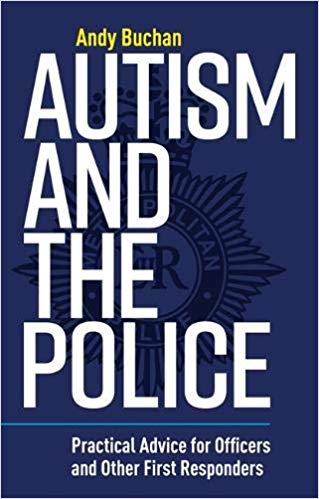With his book, Autism and the Police, ex-policeman Andy Buchan aims to improve autism awareness among police officers and all first responders, improving their interactions with the public and avoiding escalation. Here, he offers an example to show how a little understanding can go a long way.

Time and time again autistic people are stopped, checked and arrested for doing nothing more than being themselves. The way they dress, walk, speak or even just stand seems to be a beacon for a police officer to zone in on and investigate. Why is this?
The reasons run deep back into the culture of police training; from the days of Victorian ‘Peelers’ through the 1st world war and into the 1950’s up until today. One generation of trainers pass on their knowledge to the next and the result is always the same:-
‘look out for tell-tale signs of dodgy-ness’ is the simple instruction.
But what does ‘dodgy’ look like? How can one stop looking nefarious? There is no simple answer to these questions but, as an ex-copper I can tell you now that if someone is ‘up to something’ or ‘looking well dodgy’ I will be able to spot it a mile off. Why? Because I spent nigh-on 30 years watching people do criminal activities sometimes right in front of me (yes actually whilst I observed them!) and you learn to pick up on things which are just not right or ‘precursors’ as they are known.
Where do autistic people fit into all of this?
The very way an autistic person can be peculiarly dressed, walking in a really unusual way or carrying a large bag overly protectively can lead to them being stopped and checked by police officers.
That does not mean that they have a natural propensity for acting in a criminal manner, it’s just that their behaviour ‘mimics’ something we as officers are trained to spot. Let me give you an example;

A young man walks down the street and stops to look into a jeweller’s window. Whatever has drawn them to this act matters not, it is the very next thing which will bring them to the attention of a nearby police officer.
After gazing in quite closely and then running their fingers down the glass they have already pressed the interest button of the officer across the street. By turning around, spotting the officer, diverting their eyes away quickly then moving off rapidly whilst holding the large coat they are wearing tightly shut, rings alarm bells for the officer who, sets off in hot pursuit. The officer intercepts and questions the young man but the interaction does not go well. The young man is arrested.
Why?
Let me break it down for you:
- The officer is in possession of certain facts.
- The officer is strategically placed because of these facts.
- The young man ticks all of the boxes relating to these facts.
- The officer requires answers to their suspicions.
- The young man does not supply them.
- The officer feels there is no other avenue but to arrest and question further at the station.
Does this seem reasonable?
It does when you become police trained:
The jewellers has been broken into and robbed numerous times over the years. There have been a couple of ‘genuine’ suspicious characters hanging around the shop front over the last few days. This is why the officer has been specifically tasked to stand and observe.
The young man walked up in an usual way (head down and furtively). He stopped outside the shop and peered through the window then, touched the glass. Upon turning around he saw the officer but diverted his gaze and scurried off. This signals unusual behaviour and all they have been taught and feel tells the officer that this character is ‘dodgy’.
The young man is asked several times to stop but does not. Eventually the officer manages to place themselves in the young man’s way to prevent him from escaping. After several routine questions; name, address, explanation for actions, the young man has refused to reply and is still holding his long coat tightly closed. The officer can see a bulky item concealed and has no choice but to presume that it is a weapon of some sort. After a short struggle the young man is arrested.
The officer has followed their training and completed the stop/check quite lawfully.

Let’s rewind and see what it looks like from the autistic perspective:
The young man is called Aaron and he loves watches; all watches. It is a passionate hobby of his. The jewellers in the high street stocks the most expensive and attractive of them. The day is quite warm but Aaron loves his knee-length combat jacket and wears it every time he leaves the house, regardless.
On the way to the chemist to collect his prescription he stops and looks at the watches and cannot help reaching out to touch them.
He notices the time and knows he must leave to make it to the chemist before it closes. As Aaron turns he sees the officer and even though he has done nothing wrong, is fearful of the police. He does not like eye contact as it makes him feel scared so looks away.
He does not stop for the officer as he has done nothing wrong. Aaron has to get to the chemist as time is running out. He tries to dodge around the officer but is eventually blocked in. He is scared and confused by the officers questions and manner. He is innocent so cannot understand why he is being detained against his will. The final straw is when the officer asks to look inside his jacket. Inside is Aaron’s most precious book, one on watches and he will not surrender it to anyone. A struggle ensues and Aaron is arrested.
So, you can now see the incident from both sides and why the officer was suspicious. Can I say at this point that the officer has not been trained in autism and has no idea that Aaron is neurodiverse.

With just a few minor adjustments and a lot of information, the stop/check could have gone so much better. If the officer had read my book and been trained in its techniques then they may have suspected Aaron was autistic and even if he wasn’t, treating him in a different way would not have harmed the check.
I have seen so many times, situations go wrong because officers do not know what to do when they encounter neurodiverse people. They receive little or no training but are expected to simply deal with anything put in front of them sometimes by nothing but intuition and luck. This should not occur but I beg to suggest it always will as the police are usually first on the scene of most incidents. However with some quality training and the advice from my book the chances of things going wrong may dramatically reduce.
Find out more about Autism and the Police here.
If you would like to read more articles like this and get the latest news and offers on our books about autism, why not join our mailing list? We can send information by email or post as you prefer. You may also be interested in liking our Autism, Asperger’s and related conditions Facebook page.